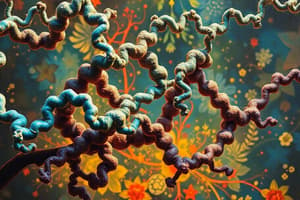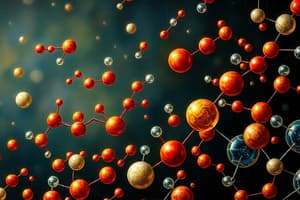Podcast
Questions and Answers
Which characteristic of proteins is demonstrated by heat coagulation and salting out?
Which characteristic of proteins is demonstrated by heat coagulation and salting out?
- Basicity
- Presence of specific chemical groups
- Colloidal nature (correct)
- Acidity
Precipitation of proteins occurs only with mineral acids.
Precipitation of proteins occurs only with mineral acids.
False (B)
What color do imino acids produce in the Ninhydrin reaction, and why?
What color do imino acids produce in the Ninhydrin reaction, and why?
yellow, due to the absence of alpha amino acids
The Ninhydrin reaction forms Ruhemann's purple by reaction with ammonia and another ___________.
The Ninhydrin reaction forms Ruhemann's purple by reaction with ammonia and another ___________.
What type of complex is formed when copper from CuSO4 reacts with peptide bonds in an alkaline medium?
What type of complex is formed when copper from CuSO4 reacts with peptide bonds in an alkaline medium?
If a solution remains blue after the Biuret test, the compound being tested contains at least two peptide bonds.
If a solution remains blue after the Biuret test, the compound being tested contains at least two peptide bonds.
Which yellow derivative is formed when the aromatic phenyl ring is nitrated in the Xanthoproteic test?
Which yellow derivative is formed when the aromatic phenyl ring is nitrated in the Xanthoproteic test?
In the Xanthoproteic test, the color changes to _______ at alkaline pH due to the ionization of the phenolic group.
In the Xanthoproteic test, the color changes to _______ at alkaline pH due to the ionization of the phenolic group.
Which specific amino acid is detected by the Millon-Nasse test?
Which specific amino acid is detected by the Millon-Nasse test?
The Hopkins-Cole reaction indicates the presence of the carboxyl group in amino acids.
The Hopkins-Cole reaction indicates the presence of the carboxyl group in amino acids.
What oxidizing agent is used in the Hopkins-Cole reaction?
What oxidizing agent is used in the Hopkins-Cole reaction?
In the presence of tryptophan, the addition of bromine water results in the formation of ________ or violet color in the alcohol layer.
In the presence of tryptophan, the addition of bromine water results in the formation of ________ or violet color in the alcohol layer.
Which two amino acids are specifically detected by the Pauly reaction?
Which two amino acids are specifically detected by the Pauly reaction?
The Pauly reaction involves the formation of a diazonium salt from sulphanilic acid.
The Pauly reaction involves the formation of a diazonium salt from sulphanilic acid.
What type of lead compound is formed in the lead acetate reaction, indicating the presence of sulfur?
What type of lead compound is formed in the lead acetate reaction, indicating the presence of sulfur?
In the Sakaguchi reaction, a-naphthol reacts with what type of compound to produce a red color?
In the Sakaguchi reaction, a-naphthol reacts with what type of compound to produce a red color?
What type of biomolecule are DNA and RNA classified as?
What type of biomolecule are DNA and RNA classified as?
Nitrogenous bases, lipids, and phosphate groups are the basic building blocks of nucleic acids.
Nitrogenous bases, lipids, and phosphate groups are the basic building blocks of nucleic acids.
What is the repeating unit of a nucleic acid called?
What is the repeating unit of a nucleic acid called?
The two structural kinds of nucleic acids are ______ and RNA.
The two structural kinds of nucleic acids are ______ and RNA.
Which of the following describes a component of the DNA extraction buffer?
Which of the following describes a component of the DNA extraction buffer?
During DNA extraction, detergent is used to break open the cell wall.
During DNA extraction, detergent is used to break open the cell wall.
DNA extraction relies on cold ethanol. What property of DNA does cold ethanol leverage during the precipitation step?
DNA extraction relies on cold ethanol. What property of DNA does cold ethanol leverage during the precipitation step?
The enzyme that can degrade or break apart DNA is known as a _________.
The enzyme that can degrade or break apart DNA is known as a _________.
What is the purpose of the purification step in DNA extraction?
What is the purpose of the purification step in DNA extraction?
Purification after DNA extraction involves rinsing with acid.
Purification after DNA extraction involves rinsing with acid.
What are the products when you subject nucleic acid to chemical or enzymatic hydrolysis?
What are the products when you subject nucleic acid to chemical or enzymatic hydrolysis?
In a nucleic acid, the bases are joined by ________ bonds.
In a nucleic acid, the bases are joined by ________ bonds.
Which test is used to detect reducing sugars?
Which test is used to detect reducing sugars?
The presence of blue after performing Benedict's test indicates the sample contains reducing sugars.
The presence of blue after performing Benedict's test indicates the sample contains reducing sugars.
The Orcinol test is used to identify what type of carbohydrate?
The Orcinol test is used to identify what type of carbohydrate?
In the absence of purine bases, the addition of hydrolysate + $NH_4$ + $AgNO_3$ does not produce a _________ precipitate.
In the absence of purine bases, the addition of hydrolysate + $NH_4$ + $AgNO_3$ does not produce a _________ precipitate.
What visual indication confirms a positive test for inorganic phosphate?
What visual indication confirms a positive test for inorganic phosphate?
The structural stability of nucleic acids rely primarily on phosphodiester, hydrogen, and hydrophilic bonds.
The structural stability of nucleic acids rely primarily on phosphodiester, hydrogen, and hydrophilic bonds.
Match the following tests with the amino acid they are designed to detect:
Match the following tests with the amino acid they are designed to detect:
Which of the following macromolecules can react to give a purple color in the Ninhydrin test?
Which of the following macromolecules can react to give a purple color in the Ninhydrin test?
The biuret test is used to test for the presence of monosaccharides in food.
The biuret test is used to test for the presence of monosaccharides in food.
Which amino acids give a positive response to the Xanthoproteic test, indicating their presence in a solution?
Which amino acids give a positive response to the Xanthoproteic test, indicating their presence in a solution?
During DNA extraction, what is the function of adding salt (sodium chloride)?
During DNA extraction, what is the function of adding salt (sodium chloride)?
A positive Xanthoproteic test will show yellow colored nitro-derivatives. Adding a base does not change the color.
A positive Xanthoproteic test will show yellow colored nitro-derivatives. Adding a base does not change the color.
How is free tryptophan detected using the Bromine Water Test, and what conditions are required?
How is free tryptophan detected using the Bromine Water Test, and what conditions are required?
Flashcards
Colloidal nature of proteins
Colloidal nature of proteins
Proteins heat coagulation or precipitation is affected by salts.
Acidity and basicity of protein Reactions
Acidity and basicity of protein Reactions
Proteins can react with acids and bases.
Ninhydrin Reaction
Ninhydrin Reaction
Free amino acids, small peptides, and proteins form a purple color when reacted.
Biuret Test
Biuret Test
Signup and view all the flashcards
Xanthoproteic Test
Xanthoproteic Test
Signup and view all the flashcards
Millon-Nasse Test
Millon-Nasse Test
Signup and view all the flashcards
Hopkins-Cole Reaction
Hopkins-Cole Reaction
Signup and view all the flashcards
Bromine Water Test
Bromine Water Test
Signup and view all the flashcards
Pauly Reaction
Pauly Reaction
Signup and view all the flashcards
Lead Acetate Reaction
Lead Acetate Reaction
Signup and view all the flashcards
Sakaguchi Reaction
Sakaguchi Reaction
Signup and view all the flashcards
Nucleic Acids
Nucleic Acids
Signup and view all the flashcards
Nucleic acids are?
Nucleic acids are?
Signup and view all the flashcards
Nucleic acids are made of?
Nucleic acids are made of?
Signup and view all the flashcards
Two structural kinds of nucleic acids
Two structural kinds of nucleic acids
Signup and view all the flashcards
The Nitrogenous Bases
The Nitrogenous Bases
Signup and view all the flashcards
Deoxyribonucleic Acid (DNA)
Deoxyribonucleic Acid (DNA)
Signup and view all the flashcards
DNA Precipitation
DNA Precipitation
Signup and view all the flashcards
DNA Purification
DNA Purification
Signup and view all the flashcards
Hydrolysis of Nucleic Acids
Hydrolysis of Nucleic Acids
Signup and view all the flashcards
Types of interactions responsible for the rigid molecular configuration of nucleic acids
Types of interactions responsible for the rigid molecular configuration of nucleic acids
Signup and view all the flashcards
Benedict's test
Benedict's test
Signup and view all the flashcards
Orcinol Test
Orcinol Test
Signup and view all the flashcards
Test for Purine Bases
Test for Purine Bases
Signup and view all the flashcards
Test for Inorganic Phosphate
Test for Inorganic Phosphate
Signup and view all the flashcards
Study Notes
Reactions of Proteins
- The colloidal nature of proteins can be observed through heat coagulation and salting out.
- Acidity and basicity of a protein refer to its reaction with a reagent, leading to precipitation by mineral acids, salts of heavy metals, and alkaloidal reagents.
- The presence of specific chemical groups determines protein reactions.
Amino Acids
- Amino acids include glycine (Gly, G), alanine (Ala, A), serine (Ser, S), threonine (Thr, T), and cysteine (Cys, C).
- Valine (Val, V), leucine (Leu, L), isoleucine (Ile, I), methionine (Met, M), and proline (Pro, P) belong to amino acids family.
- Phenylalanine (Phe, F), tyrosine (Tyr, Y), tryptophan (Trp, W), aspartic acid (Asp, D), glutamic acid (Glu, E) are also types of amino acids.
- Asparagine (Asn, N), glutamine (Gln, Q), histidine (His, H), lysine (Lys, K), and arginine (Arg, R) are amino acids as well.
Ninhydrin Reaction
- Free amino acids, small peptides, and proteins react with ninhydrin, producing a purple color.
- Ninhydrin forms hydrindantin with amino acids, which then reacts with ammonia and another ninhydrin molecule to create Ruhemann's purple.
- Imino acids yield a yellow color due to the absence of alpha amino acids.
Biuret Test
- Copper from copper sulfate forms a coordination complex with peptide bonds in an alkaline medium.
- Compounds containing two or more peptide bonds react with cupric ions in a basic solution, resulting in a violet-pink complex.
- A blue solution indicates the tested compound is an amino acid, a dipeptide, or neither
Xanthoproteic Test
- Aromatic amino acids like phenylalanine, tyrosine, and tryptophan respond positively.
- Phenylalanine shows a weak positive result.
- Concentrated nitric acid causes the aromatic phenyl ring to undergo nitration, producing yellow colored nitro-derivatives.
- At alkaline pH, the color shifts to orange because of the phenolic group's ionization.
Millon-Nasse Test
- Specifically tests for the phenolic group of tyrosine; the hydroxy benzene group reacts with Millon's reagent, forming a red colored complex.
Hopkins-Cole Reaction
- Presence of amino acid containing indole group is indicated by the test.
- Glyoxylic acid functions as the oxidizing agent, oxidizing the indole nucleus of tryptophan.
- The oxidized indole ring reacts with formaldehyde, giving a violet colored ring where two liquids connect.
Bromine Water Test
- This test identifies free tryptophan.
- Adding bromine water and n-amyl alcohol to a sample with tryptophan leads to the formation of a pinkish lavender or violet color in the alcohol layer.
Pauly Reaction
- Specifically identifies tyrosine or histidine.
- The reagent contains sulphanilic acid dissolved in hydrochloric acid.
- Upon diazotization, sulphanilic acid, in the presence of sodium nitrite and hydrochloric acid, forms a diazonium salt.
- The diazonium salt couples with either tyrosine or histidine, in an alkaline medium, the product is a red coloured chromogen (azo dye).
Lead Acetate Reaction
- Boiling a protein solution with an alkali splits the sulfur of cysteine and cystine, forming sodium sulfide.
- Black lead sulfate is formed when this combines with lead acetate.
- Methionine does not answer this test as sulfur is in a thioether linkage and isn't split through boiling with strong alkali.
Sakaguchi Reaction
- Under alkaline conditions, α-naphthol (1-hydroxy naphthalene) reacts with Arginine.
- When treated with hypobromite or hypochlorite, it forms a red color indicating a positive result.
- Arginine, whether free or combined, tests positive.
Nucleic Acids
- Nucleic Acids are macrobiopolymers, high molecular weight, with mononucleotide as the repeating unit.
- The two structural types are DNA and RNA, made of nitrogenous bases, sugar, and a phosphate group.
- Nitrogenous bases can be pyrimidines (cytosine, thymine, uracil) or purines (adenine & guanine).
- Deoxyribonucleic Acid carries genetic information
DNA Extraction Process
- Lysis involves breaking open cells to release the nucleus, and then breaking the nucleus to release DNA.
- DNA extraction buffer components include H₂O and detergent, which contains surfactants to dissolve the cell membrane (lipid bilayer).
- Sodium chloride removes proteins and carbohydrates.
- Borax buffers the pH, and ethanol precipitates the dissolved DNA.
- Cold ethanol precipitates DNA; it's less soluble in alcohol
- Low temperatures protects by slowing enzyme activity, which prevents nucleases from breaking it down .
- Purification removes remaining cellular debris and unwanted material and is done by alcohol rinsing.
- Hydrolysis of nucleic acid by either chemical or enzymatic methods, yields purine and pyrimidine bases, oligonucleotides which may contain upto 20 residues linked together, nucleosides, ribose or deoxyribose and phosphates.
Interactions of Nucleic Acids
- Phosphodiester bonds join nucleotides in each chain.
- Hydrogen bonds join the bases.
- Van der Waal's forces between stacked bases
Qualitative Tests for Nucleic Acids
- Benedict's test (test for reducing sugars)
- Orcinol Test (test for pentoses)
- Test for purine bases
- Test for inorganic phosphate
Benedict's Test
- Test for reducing sugars where aldehydes and ketones are oxidized in the presence of an alkaline alkaline copper solution
- The cupric ions are reduced to cuprous and brick-red Cu₂O creating a precipitate
Orcinol Test
- Test for pentoses where pentoses decomposes after being heated with concentrated hydrochloric acid, resulting in the formation of furfural
- The furfural them condenses with orcinol (3,5-dihydrotoluene) to give blue colored compounds
Test for Purine Bases
- Hydrolysate + NH4 + AgNO3 creates a whitish precipitate
- Unhydrolyzed +NH4 + AgNO3 creates a Grayish-white precipitate
Test for Inorganic Phosphate
- Presence of inorganic phosphate can be detected though the the formation of a yellow precipitate after specific binding.
Studying That Suits You
Use AI to generate personalized quizzes and flashcards to suit your learning preferences.




